This article outlines the differences between sativa and indica cannabis plants. Read on to learn more about the origins of sativa and indica, plus how they differ in growth patterns, appearance, and the effects they produce after consumption.
- What are the origins? – Indica vs Sativa
- The difference in physical appearance between Sativa and Indica
- Flowering time – Indica vs Sativa
- The difference in size between Indica and Sativa
- The difference in effect – Indica vs Sativa
- It can be difficult both to explain and to comprehend the difference between indica and sativa highs
- The typical effects of indica
- ‘Stoner’ stereotypes
- The typical effects of sativa
- The effects of indica vs sativa: the plot twist
- Once again, everything we know is wrong
- An exercise in futility
- Mapping a complete biochemical fingerprint
- We are only just delving into the deep science of cannabis
The two most well known types of cannabis plants are Indica and Sativa. The differences between Indica dominant cannabis strains and Sativa dominant cannabis strains are many and varied.
Indica strains have a different range of effects on the body and mind than Sativa strains. Both have different medicinal benefits.
An Indica strain is generally associated with a sense of deep body relaxation. Sativa strains tend to provide a more energizing experience.
Scientifically (and legally), there is no difference between Indica and Sativa cannabis plants. And all cannabis plants are considered to be Cannabis Sativa L..
There are a multitude of different growth-patterns, qualities and effects within the ‘spectrum’ of cannabis.
The differences between Indica and Sativa are largely due to the fact that cannabis displays a remarkable ability to adapt to a wide range of different environments.
Since all branches of the cannabis family tree can interbreed freely (including industrial hemp and Cannabis ruderalis J.), some botanists consider all forms of the plant to be members of a single polymorphic species.
What are the origins? – Indica vs Sativa
Cannabis Indica L.
Most indica varieties come from central Asia and the Indian subcontinent – Afghanistan, Pakistan, northern India, Tibet, Nepal, and so on.
Cannabis Sativa L.
Sativas generally originate in the equatorial regions – Thailand, southern India, Jamaica, Mexico, and so forth.
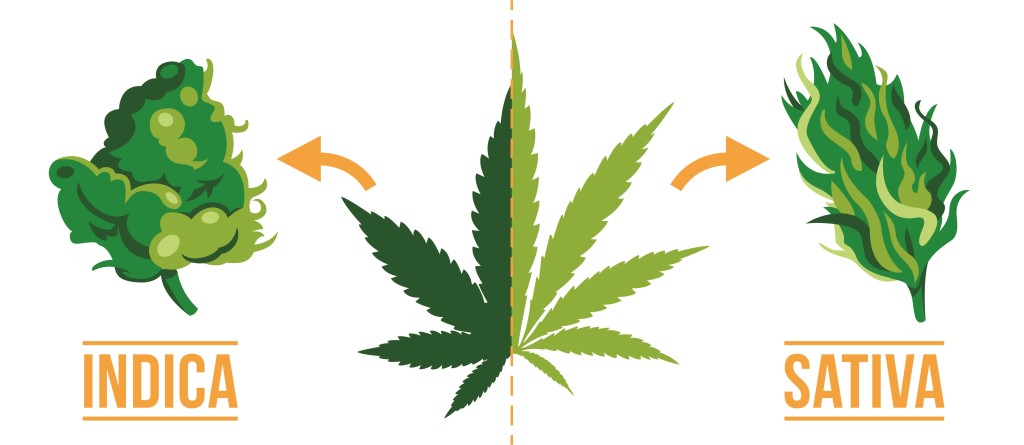
The difference in physical appearance between Sativa and Indica
Indicas are compact and stocky, with dense, heavy, fragrant buds.
Cannabis plants produce nodes at regular intervals along their stems, and these nodes are the sites at which leaves, branches and flowers (buds) form. Indica buds tend to grow in dense clusters around the nodes of the stem and branches, with relatively short spaces (known as internodal gaps) between each cluster.
Given the same conditions, sativas grow taller than Indicas.
Sativa buds tend grow larger than Indica, as they run along the length of a branch instead of clustering around the nodes. However, they will usually weigh less than Indica when dry, due to their lower density.
Sativa buds also tend to have a less striking odour, both when growing and when dry.
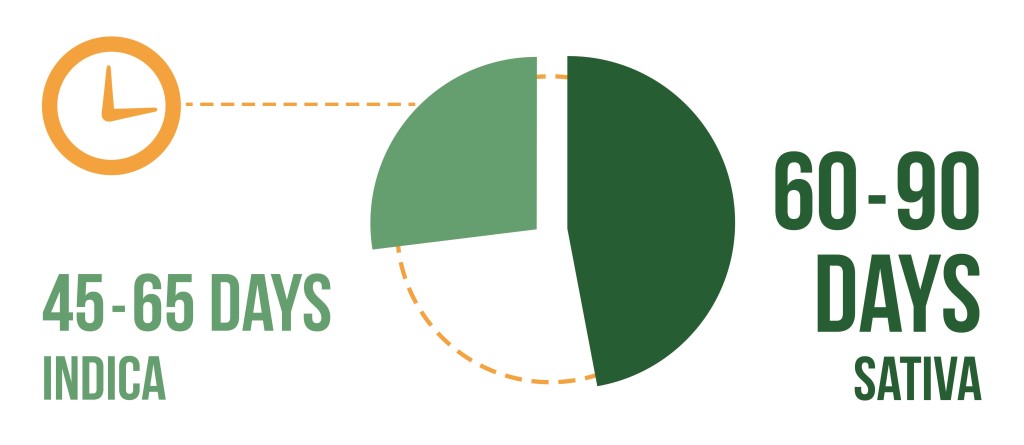
Flowering time – Indica vs Sativa
Indicas are the faster flowering varieties and usually have a flowering time of 45 to 60 days.
A major difference between indica vs sativa is that sativas take longer to flower. They will usually need between 60 and 90 days to finish blooming.
However, they need less time for vegetative growth prior to flowering than Indicas do, so the overall time required for Sativas is about the same as for Indicas (and sometimes less in terms of ‘light hours’).
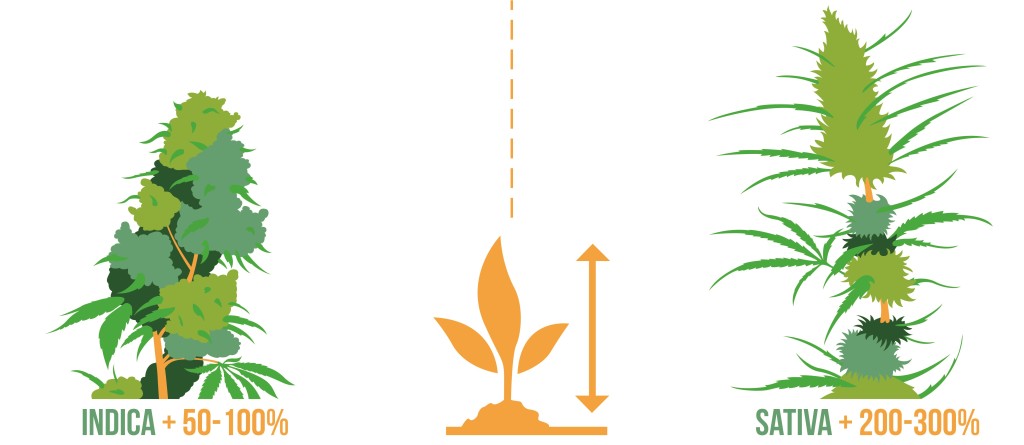
The difference in size between Indica and Sativa
Indicas gain height quite rapidly once flowering begins, but they shouldn’t grow out of control in normal circumstances.
An Indica may be expected to increase its vegetated height by a factor of 50-100% during its flowering period.
In tropical regions, the days tend to be relatively short – close to 12 hours long all year round – so Sativas are adapted to grow and flower at the same time instead of having distinct vegetative and blooming stages as Indicas do.
In a 12/12 indoor flowering cycle, sativas will grow and flower at the same time as they would in their native environment.
Sativas can increase in height very rapidly once flowering begins and will often continue to gain height throughout their blooming phase.
It is normal for sativas to gain 200-300% (or even more) of their vegetative height while flowering.
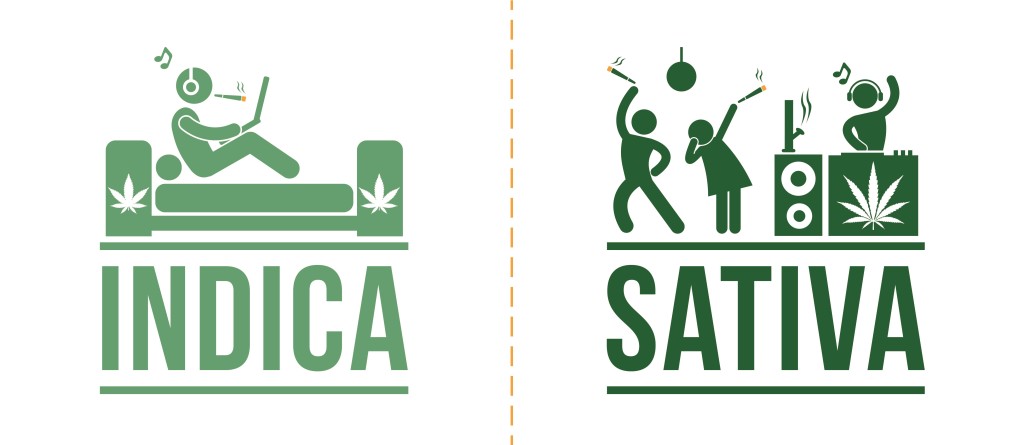
The difference in effect – Indica vs Sativa
Perhaps the most profound, yet trickiest to describe, difference between indica and sativa cannabis strains is their effect. This can be especially difficult to grasp for people who have never used psychoactive substances. Plus, new evidence suggests the cause of the difference is not what we always thought!
There are various posts on this blog about the physical, historical or geographical differences between the two main types of our favourite plant, but this article focuses on the differences between the effects of indica and sativa cannabis strains. (For simplicity’s sake, we will take ‘indica’ to mean ‘indica-dominant’ and sativa to mean ‘sativa-dominant’ in this context.)
‘Being stoned’ on indica vs ‘being high’ on sativa
Experienced cannabis users often refer to the effects of indica as ‘being stoned’, and the effects of sativa as ‘being high’, so that their audience knows what sort of state of mind they are in. Examples of this could be “I really don’t want to move off this couch right now, I’m so stoned I feel like I’m sitting on a big warm cloud”, and “I’m so high, do you want to bake biscuits or just watch some comedy? Because I’m so high. No, seriously, stop laughing, I am so. High.”.
This is all very well if you have experienced these states yourself, but they are not the easiest thing to accurately describe to those who have not! Writers from Charles Baudelaire to Jack Kerouac have wrapped their minds and words around the altered states created by cannabis, and attempted to take their readers with them to the worlds that they have explored whilst under its influence.
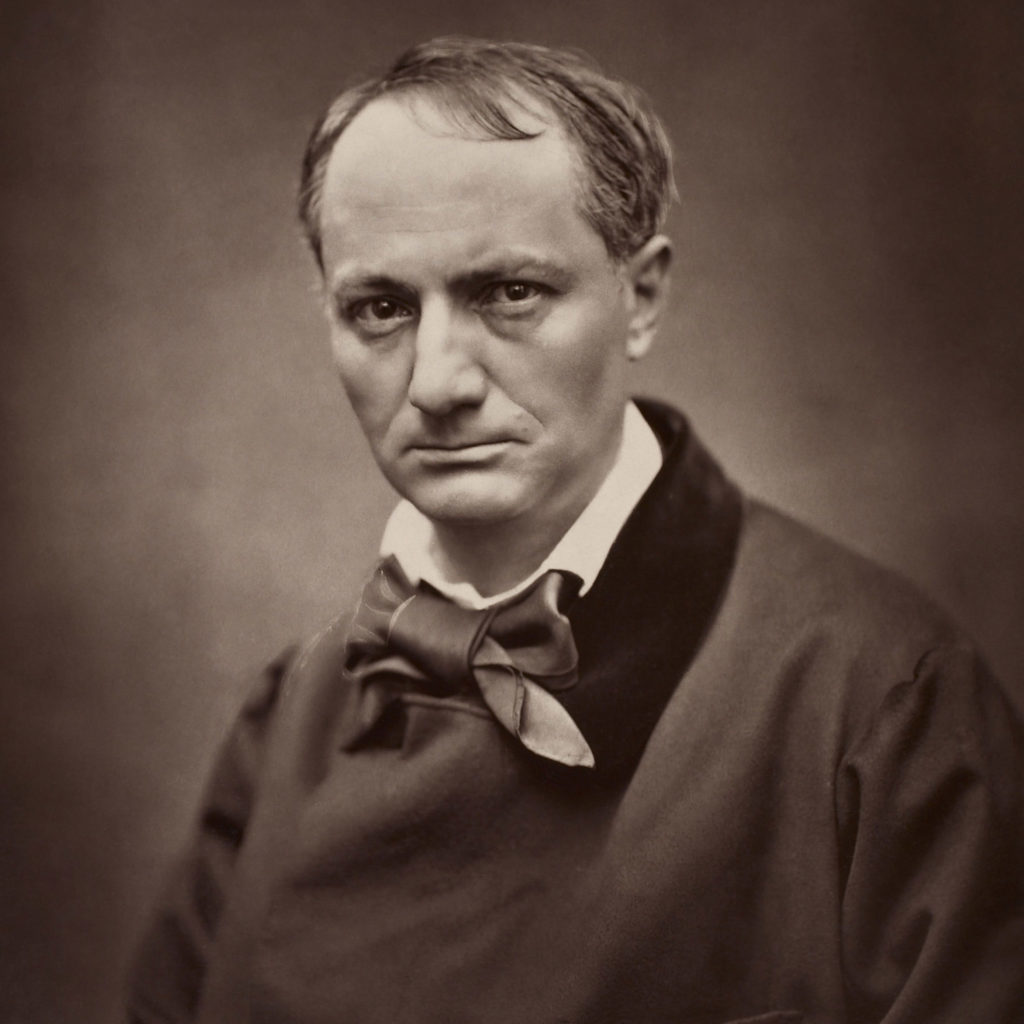
It can be difficult both to explain and to comprehend the difference between indica and sativa highs
A great deal of how the words of a psychonaut will be interpreted, and how successful they are in imparting the subjective truth of their experience, depends on the reader themselves. If the reader has not experienced anything comparable to the different psychoactive effects of indica, sativa, or both, can they really understand what the writer means?
Luckily, this article is not required to compete with the likes of Kerouac and Baudelaire, merely to try to explain to both the initiated and the inexperienced what the various results of consuming sativa or indica can be. It should also be pointed out that one is not objectively ‘better’ than the other; one of the great things about cannabis is how it seems to have an application for every occasion!
The typical effects of indica
Indica cannabis strains are associated with a feeling of relaxation in the body, as though stress is flowing out of the muscles. If you feel tense, or as though you are overwhelmed by pressure, consuming some indica can release this discomfort and replace it with a soporific ease. Imagine the feeling of sinking into a warm bath, or relaxing after a good massage.

Thoughts slow down, time seems to slow down, and, in classic ‘stoner’ fashion, it is possible that you will become so relaxed that you forget what you were doing, or were about to do! An often-referenced difference between indica and sativa effects is that indicas produce a feeling of sleepiness and passivity, whereas sativas induce an urge for activity.
‘Stoner’ stereotypes
It is interesting to note that due to prohibition, most illegally grown and sold cannabis is indica, since there is less risk associated with its quicker turnover and larger yields. The negative media portrayal of the ‘lazy, apathetic stoner’ could in part be due to the prevalence of indica among people forced to acquire cannabis illegally. With the major changes in legislation happening (especially in the US) and the new availability of sativas, in a few years’ time we may see a new stereotype – the ‘giggling, get up and go’ cannabis user. Which brings us to:
The typical effects of sativa
Sativa cannabis strains are associated with a feeling of rising or being uplifted in the head and mind. Creativity may begin to flow to the extent that you suddenly realise you have been staring into space as idea after idea goes through your mind, and concepts which previously seemed to have no connection join together to create new inspiration. There are numerous anecdotal reports, and even some science, on the tendency of cannabis to enhance pattern recognition. There are no studies on whether sativas produce this effect more than indicas, but this may well be the case.

Things can also strike you as funny, or far funnier than usual. Sativas have the power to render you helpless with laughter, suddenly gifted with a new appreciation for the absurd. An energetic desire to do something can seize you; what that ‘something’ is relies very much on the individual. Athletes may go for a run or work out. Artists may create, musicians may play music, gardeners may garden, and so on. The inspiration granted by the effect of sativas will manifest in what comes to hand for you.
The effects of indica vs sativa: the plot twist
Cannabis sativa L. was first classified in 1753 CE; Cannabis indica Lam. in 1785 CE. These classifications were not based upon effect, but botany. Modern cannabis authors such as Robert Connell Clarke built upon these classifications in their early works. They added more information about the type of high or stone that would be experienced from sativas and indicas.
Research into the effects of cannabis led to the discovery, and then synthesis of, CBD in 1963 and THC in 1964. For decades, it was thought that sativa cannabis strains contained higher levels of THC and indica cannabis strains contained higher levels of CBD. The restrictions of prohibition meant that this information mostly spread by word of mouth, but spread it did.
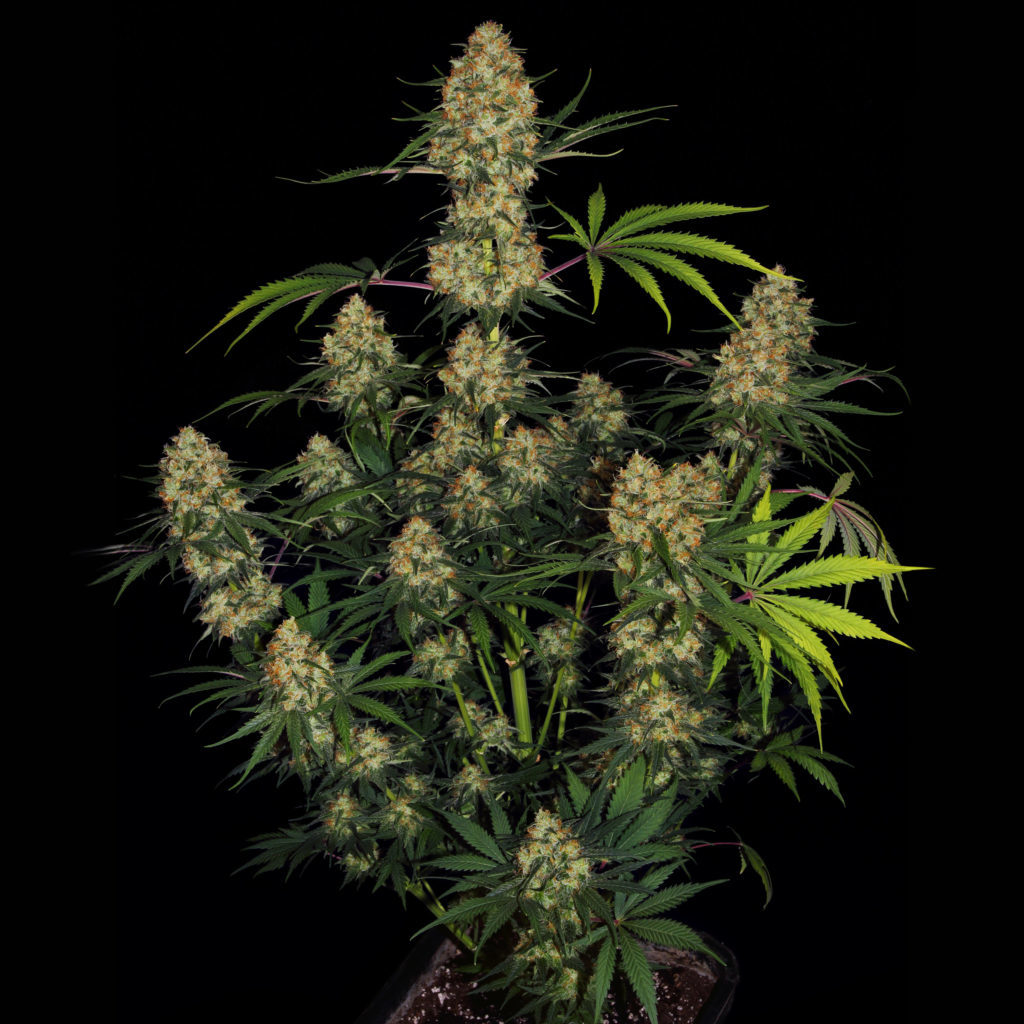
All the information about the different effects of sativa and indica described above has been ‘known’ since at least the 1970s, when dedicated breeding schemes and access to genetics from around the world came together. Ben Dronkers and his contemporaries were instrumental in honing and refining wild landrace strains into the building blocks of the modern cannabis seed industry – indicas, sativas, and hybrids.
The plethora of cannabis hybrids grows exponentially year by year, and research into the chemistry and taxonomy of cannabis barely keeps pace. Although humans have known that cannabis has a psychoactive effect for thousands of years, we have only known why – the existence of the endocannabinoid system – since the late 1980s.
The objective science of cannabis is still in its infancy. Compared to the subjective experience of millions of cannabis users, it’s practically still gestating. What is all this leading to? The revelation that there is barely any difference in CBD and THC levels between sativa and indica.
Once again, everything we know is wrong
With the publication of ‘Cannabis: Evolution and Ethnobotany’ in 2013, the vernacular definitions of indica and sativa (despite being built upon the work of Linnaeus and Lamarck) were called into question for both accuracy and usefulness.
The terms ‘broad leafed hemp/drug’ and ‘narrow leafed hemp/drug’ were proposed instead, to more properly describe four main types of cannabis rather than two. In practice, this has still yet to catch on. (Sensi Seeds continues to use the vernacular terms and definitions because these are most easily found, and understood, by our audience.)
In the last two years, research based on scientific rather than anecdotal evidence has been published that contradicts everything we thought we knew about the difference between not just the appearance and evolution, but also the effects of indica and sativa.
An exercise in futility
Dr Ethan Russo is a neurologist, psychopharmacology researcher, and Medical Director of PHYTECS, a biotechnology company researching the human endocannabinoid system. In this compelling interview from 2016, he holds nothing back in his assessment of the current popular understanding of the differences between the effects of indica and sativa:
“…the sativa/indica distinction as commonly applied in the lay literature is total nonsense and an exercise in futility … it is necessary to quantify the biochemical components of a given Cannabis strain and correlate these with the observed effects in real patients.”
Dr Russo goes on to say that monoterpenes are behind the different effects of different types of cannabis. The sedative effect associated with indica strains and their supposed high CBD, low THC content is due to myrcene. The uplifting feeling we associate with the putative high THC, low CBD sativas is thanks to limonene (also found in citrus peels).
Dr Ryan Vandrey, a behavioural pharmacologist at Johns Hopkins who specializes in cannabis and cannabinoids, disagrees with Dr Russo’s assessment, citing limited science on the topic. This article explores the different scientific viewpoints and available research on the subject in 2016, and this one from 2018 adds more detail about terpenes.
Mapping a complete biochemical fingerprint
If you want to really get into the science, ‘Cannabis: From Cultivar to Chemovar II—A Metabolomics Approach to Cannabis Classification’ from 2016 seems to be the most in-depth study so far. It postulates that the use of chemovar mapping – creating a kind of complete biochemical ‘fingerprint’ for each strain, based on its cannabinoid, monoterpene, and sesquiterpene profiles – is the best way of determining nomenclature.
This study also has a conclusion which holds some hope for the retention of the simple, familiar distinctions of sativa and indica. “… vernacularly labeled Sativa and Indica accessions could be well separated into two distinct groups, which means that true differences seem to exist in chemical composition between these two types of cannabis”.
Rather than basing these classifications on the THC:CBD ratio, other cannabinoids, and terpenes, are used. The less well-known cannabinoids cannabichromene (CBC) and cannabigerol (CBG) were found to be “slightly but significantly higher” in the strains named as sativas. For “the identification of (vernacular) Indica [sic]” types, the different terpene composition and the presence of hydroxylated terpenes are described as “good chemical markers”.
We are only just delving into the deep science of cannabis
This fits not only the scientific, but the anecdotal evidence. Experience incontrovertibly tells us that different types of cannabis produce different effects; the only problem is, we thought we knew why but we’re only just beginning to scratch the surface of the topic.
You could think of it as being like the evolution of planetary science. Humans have always seen the sun moving across the sky. The theories as to why it does so have evolved from the Earth being flat with the sun embedded in a moving dome above it, then the sun circling a spherical Earth, then a spherical Earth circling the sun in one tiny galaxy out of a potential number of two trillion galaxies.
Despite what we have learned about it, the sun has continued to travel across the sky in the same way; despite what we learn about cannabis, different types will continue to have different effects upon us.
Thanks for reading all of what was originally going to be a short and simple article! What do you think about the different effects of various types of cannabis? Have you ever experienced a sativa high from buds that were supposed to be indica, or vice versa? Let us know in the comments below!
- Disclaimer:Laws and regulations regarding cannabis cultivation differ from country to country. Sensi Seeds therefore strongly advises you to check your local laws and regulations. Do not act in conflict with the law.










I am in cultivation 20 years ago.
Until now any of my Indicas had the indicas effect and any of my sativa’s had the uplifting effect.
I have a plant that appears to be sativa, long skinny leaves. It has almost consistently put only a single leaf. It has been grown outdoors. It is probably about two weeks away from harvest right now. Any ideas on what I might have? I am a complete novice, first plant ever grown.